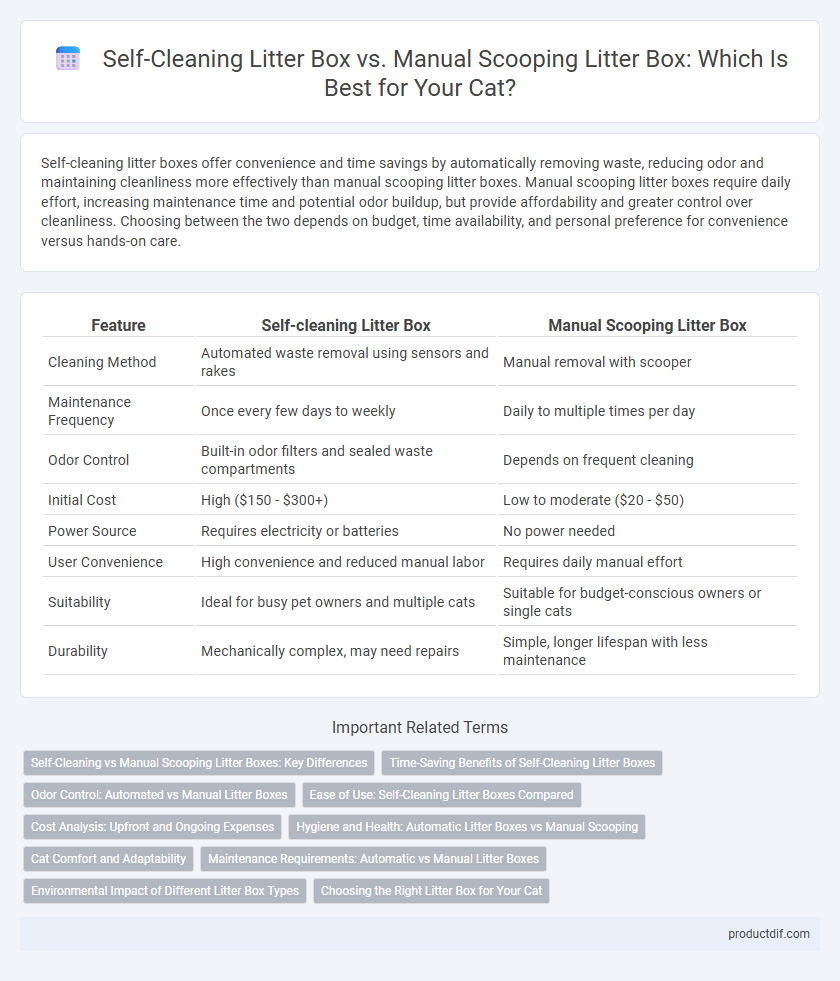Self-cleaning litter boxes offer convenience and time savings by automatically removing waste, reducing odor and maintaining cleanliness more effectively than manual scooping litter boxes. Manual scooping litter boxes require daily effort, increasing maintenance time and potential odor buildup, but provide affordability and greater control over cleanliness. Choosing between the two depends on budget, time availability, and personal preference for convenience versus hands-on care.
Table of Comparison
| Feature | Self-cleaning Litter Box | Manual Scooping Litter Box |
|---|---|---|
| Cleaning Method | Automated waste removal using sensors and rakes | Manual removal with scooper |
| Maintenance Frequency | Once every few days to weekly | Daily to multiple times per day |
| Odor Control | Built-in odor filters and sealed waste compartments | Depends on frequent cleaning |
| Initial Cost | High ($150 - $300+) | Low to moderate ($20 - $50) |
| Power Source | Requires electricity or batteries | No power needed |
| User Convenience | High convenience and reduced manual labor | Requires daily manual effort |
| Suitability | Ideal for busy pet owners and multiple cats | Suitable for budget-conscious owners or single cats |
| Durability | Mechanically complex, may need repairs | Simple, longer lifespan with less maintenance |
Self-Cleaning vs Manual Scooping Litter Boxes: Key Differences
Self-cleaning litter boxes use automated mechanisms such as rakes or rotating trays to separate clumps and waste, reducing odor and maintenance time compared to manual scooping litter boxes. Manual scooping requires regular hand-scooping of waste, making it more labor-intensive but typically more affordable and simple to maintain. The choice between the two hinges on factors like convenience, budget, and the pet owner's preference for cleaning frequency and effort.
Time-Saving Benefits of Self-Cleaning Litter Boxes
Self-cleaning litter boxes significantly reduce the time spent on daily maintenance by automating waste removal, allowing pet owners to focus on other tasks. Unlike manual scooping litter boxes that require frequent attention and physical effort, these automated systems use sensors to detect waste and clean efficiently, minimizing odor and mess. Time-saving benefits translate into enhanced convenience and improved hygiene for both pets and owners.
Odor Control: Automated vs Manual Litter Boxes
Self-cleaning litter boxes utilize advanced sensors and airtight sealing mechanisms to significantly reduce odor by promptly removing waste and controlling moisture levels, ensuring a fresher environment for pets and owners. Manual scooping litter boxes rely on regular human intervention, which can lead to inconsistent odor control and lingering ammonia buildup if scooping frequency is inadequate. Automated systems often incorporate carbon filters or deodorizing agents, providing superior odor management compared to traditional manual scooping methods.
Ease of Use: Self-Cleaning Litter Boxes Compared
Self-cleaning litter boxes offer superior ease of use by automatically separating waste, reducing manual scooping to minimal maintenance. Manual scooping litter boxes require daily effort to remove clumps, increasing time and physical labor for pet owners. Automated features in self-cleaning models enhance convenience and hygiene, making them a preferred choice for busy households.
Cost Analysis: Upfront and Ongoing Expenses
Self-cleaning litter boxes typically have a higher upfront cost ranging from $150 to $500, while manual scooping litter boxes usually cost between $15 and $50. Ongoing expenses for self-cleaning models include replacement parts and specialized litter costing $20 to $40 per month, compared to manual scooping boxes that require only standard cat litter costing $10 to $30 monthly. Over time, manual scooping litter boxes tend to be more cost-effective due to lower initial investment and minimal maintenance fees.
Hygiene and Health: Automatic Litter Boxes vs Manual Scooping
Self-cleaning litter boxes significantly improve hygiene by automatically removing waste, reducing bacterial growth and odor compared to manual scooping litter boxes. The consistent waste removal minimizes direct contact with harmful pathogens, thereby lowering the risk of infections for both cats and owners. Manual scooping often results in irregular cleaning, which can lead to increased exposure to allergens and compromised feline health.
Cat Comfort and Adaptability
Self-cleaning litter boxes provide consistent cleanliness that enhances cat comfort by reducing odors and bacteria, promoting a healthier environment. Cats typically adapt faster to automated systems due to the stable and odor-free litter surface compared to manual scooping, which can result in irregular cleaning schedules. However, some cats may require gradual introduction to self-cleaning models to adjust comfortably to the new noise and motion.
Maintenance Requirements: Automatic vs Manual Litter Boxes
Self-cleaning litter boxes significantly reduce maintenance by automatically sifting and disposing of waste, minimizing daily scooping tasks and controlling odors more effectively than manual scooping litter boxes. Manual litter boxes require frequent, hands-on scooping multiple times a day to maintain hygiene and prevent unpleasant smells. The investment in an automatic litter box offers convenience and consistent cleanliness, while manual options demand regular attention and time commitment.
Environmental Impact of Different Litter Box Types
Self-cleaning litter boxes typically use more electricity and generate additional electronic waste compared to manual scooping litter boxes, which consume no power and produce less non-biodegradable waste. Manual scooping litter boxes often rely on biodegradable litter materials that reduce environmental footprint, whereas self-cleaning boxes may require specialized, less eco-friendly litter types. Choosing manual scooping options can support sustainable pet care by minimizing energy consumption and promoting the use of eco-conscious litter products.
Choosing the Right Litter Box for Your Cat
Choosing the right litter box for your cat involves evaluating convenience, hygiene, and your cat's comfort. A self-cleaning litter box reduces odor and maintenance time by automatically sifting waste, while manual scooping litter boxes offer budget-friendly control and familiarity for cats sensitive to change. Prioritize your cat's habits and your lifestyle to select a solution that ensures cleanliness and ease of use for both you and your feline companion.
Self-cleaning Litter Box vs Manual Scooping Litter Box Infographic

 productdif.com
productdif.com